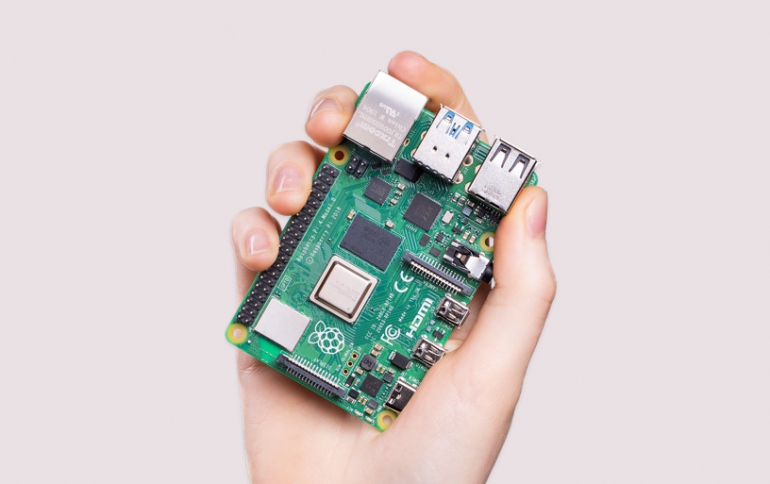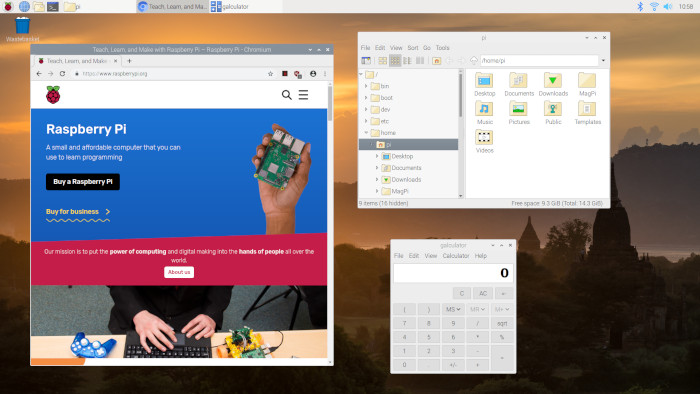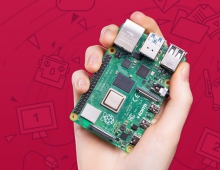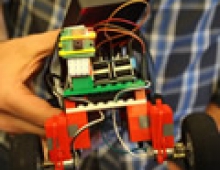
New Raspberry Pi 4 Could be Your New Computer For Just $35
A seriously upgraded Raspberry Pi device is not on sale, starting at $35.
The Raspberry Pi 4 is provides a PC-like level of performance for most users, while retaining the interfacing capabilities and hackability of the classic Raspberry Pi line.
Here are the highlights:
- A 1.5GHz quad-core 64-bit ARM Cortex-A72 CPU (~3× performance)
- 1GB, 2GB, or 4GB of LPDDR4 SDRAM
- Full-throughput Gigabit Ethernet
- Dual-band 802.11ac wireless networking
- Bluetooth 5.0
- Two USB 3.0 and two USB 2.0 ports
- Dual monitor support, at resolutions up to 4K
- VideoCore VI graphics, supporting OpenGL ES 3.x
- 4Kp60 hardware decode of HEVC video
- Complete compatibility with earlier Raspberry Pi products

This is the first time a Raspberry is offerd with a choice of memory capacities:
- 1GB $35
- 2GB $45
- 4GB $55
Specs
- Broadcom BCM2711, Quad core Cortex-A72 (ARM v8) 64-bit SoC @ 1.5GHz
- 1GB, 2GB or 4GB LPDDR4-2400 SDRAM (depending on model)
- 2.4 GHz and 5.0 GHz IEEE 802.11ac wireless, Bluetooth 5.0, BLE
- Gigabit Ethernet
- 2 USB 3.0 ports; 2 USB 2.0 ports.
- Raspberry Pi standard 40 pin GPIO header (fully backwards compatible with previous boards)
- 2 × micro-HDMI ports (up to 4kp60 supported)
- 2-lane MIPI DSI display port
- 2-lane MIPI CSI camera port
- 4-pole stereo audio and composite video port
- H.265 (4kp60 decode), H264 (1080p60 decode, 1080p30 encode)
- OpenGL ES 3.0 graphics
- Micro-SD card slot for loading operating system and data storage
- 5V DC via USB-C connector (minimum 3A*)
- 5V DC via GPIO header (minimum 3A*)
- Power over Ethernet (PoE) enabled (requires separate PoE HAT)
- Operating temperature: 0 – 50 degrees C ambient
* A good quality 2.5A power supply can be used if downstream USB peripherals consume less than 500mA in total.
At first glance, the Raspberry Pi 4 board looks very similar to the previous $35 products, all the way back to 2014’s Raspberry Pi 1B+.
The device moves from USB micro-B to USB-C for a power connector. This supports an extra 500mA of current, ensuring we have a full 1.2A for downstream USB devices, even under heavy CPU load.
To accommodate dual display output within the existing board footprint, the type-A (full-size) HDMI connector has been replaced with a pair of type-D (micro) HDMI connectors.
The Gigabit Ethernet magjack has moved to the top right of the board, from the bottom right, simplifying PCB routing. The 4-pin Power-over-Ethernet (PoE) connector remains in the same location, so Raspberry Pi 4 remains compatible with the PoE HAT.
The Ethernet controller on the main SoC is connected to an external Broadcom PHY over a dedicated RGMII link, providing full throughput. USB is provided via an external VLI controller, connected over a single PCI Express Gen 2 lane, and providing a total of 4Gbps of bandwidth, shared between the four ports.
All three connectors on the right-hand side of the board overhang the edge by an additional millimetre, with the aim of simplifying case design. In all other respects, the connector and mounting hole layout remains the same, ensuring compatibility with existing HATs and other accessories.
To support Raspberry Pi 4, a radically overhauled operating system is shipping, based on the forthcoming Debian 10 Buster release. This brings numerous behind-the-scenes technical improvements, along with an extensively modernised user interface, and updated applications including the Chromium 74 web browser.

Raspberry Pi 4 is built around BCM2711, a complete re-implementation of BCM283X on 28nm. The power savings delivered by the smaller process geometry have allowed Raspberry to replace Cortex-A53 with the much more powerful, out-of-order, Cortex-A72 core; this can execute more instructions per clock, yielding performance increases over Raspberry Pi 3B+ of between two and four times, depending on the benchmark.
Raspberry 4 also moves to a more modern memory technology, LPDDR4, tripling available bandwidth; the entire display pipeline has been upgraded, including video decode, 3D graphics and display output to support 4Kp60 (or dual 4Kp30) throughput; and the non-multimedia I/O limitations of previous devices have beeb addressed by adding on-board Gigabit Ethernet and PCI Express controllers.
Those who are keen to get going with Raspbian Buster right away, are recommend to download a new image, rather than upgrading an existing card.
One notable step forward is that for Raspberry Pi 4, the legacy graphics driver stack used on previous models hsa been retired. Instead, the Mesa “V3D” driver developed by Broadcom is used. This offers many benefits, including OpenGL-accelerated web browsing and desktop composition, and the ability to run 3D applications in a window under X. It also eliminates roughly half of the lines of closed-source code in the platform.
A new two-part case is priced at $5. In addition, a 5V/3A power supply is priced at $8, and is available in UK (type G), European (type C), North American (type A) and Australian (type I) plug formats.

If you’d like to re-use a Raspberry Pi 3 Official Power Supply, resellers are offering a $1 adapter which converts from USB micro-B to USB-C.
Low-cost micro HDMI cables which reliably support the 6Gbps data rate needed for 4Kp60 video can be hard to find. An 1m cable will be available from resellers for $5.
Bringing all of this together, Raspberry is offering a complete Desktop Kit. This is priced at $120, and comprises:
- A 4GB Raspberry Pi 4
- An official case
- An official PSU
- An official mouse and keyboard
- A pair of HDMI cables
- A copy of the updated Beginner’s Guide
- A pre-installed 32GB microSD card
Raspberry promised to continue selling the older Raspberry Pi 1B+, 2B, 3B, and 3B+ for $25, $35, $35, and $35 respectively.



















